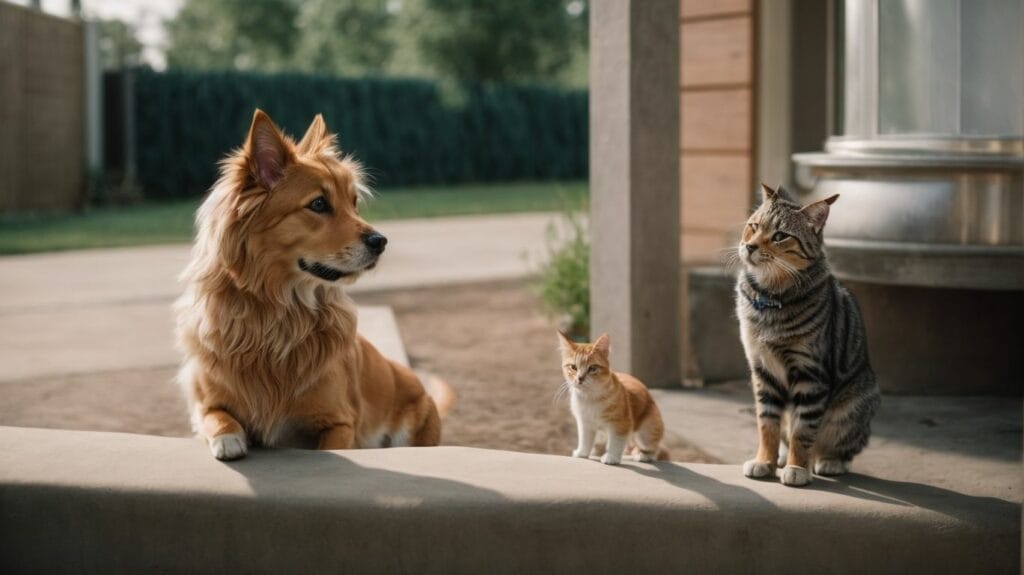Laying to rest the common question and concern, “Will dogs eat cats?” requires understanding the complex dynamics between these two animals. While it is not typical for dogs to eat cats, their behavior towards each other can vary based on a range of factors. Observations from reputable sources like the American Society for the Prevention of Cruelty to Animals (ASPCA) and renowned animal behaviorist Karen L. Overall shed light on this topic.
Examining the natural relationship between dogs and cats, it is essential to recognize that they are both predatory species, but they have distinct social structures and communication styles. Factors that influence dog-cat interactions include socialization, prey drive, breed, and size, as well as individual personality traits.
Understanding the signs of aggression in dogs towards cats is crucial to ensure their safety and harmonious coexistence. Certain behaviors, such as growling, lunging, and chasing, may indicate aggression.
To successfully introduce dogs and cats, a gradual and controlled environment is essential. Tips for introducing them include gradual introductions, providing a controlled environment, and using positive reinforcement techniques.
Supervision is crucial when dogs and cats live together to ensure their safety and prevent any potential conflicts. However, if your dog displays aggression towards cats, it is important to seek professional help and consider implementing behavior modification techniques to address the issue effectively.
By understanding the dynamics between dogs and cats and following these guidelines, you can foster a peaceful and harmonious relationship between your canine and feline companions.
Key takeaways:
- Dog-cat interactions are influenced by factors such as socialization, prey drive, breed and size, and individual personality.
- Introducing dogs and cats should be done gradually in a controlled environment with positive reinforcement.
- Supervision is crucial when dogs and cats live together to ensure their safety and prevent aggressive behavior.
Will Dogs Eat Cats?

Photo Credits: Petnarnia.Com by Jordan Clark
When it comes to the question of “Will Dogs Eat Cats?” there is no definitive answer. While some dogs might have a prey drive and display aggression towards cats, not all dogs will exhibit this behavior. It largely depends on the individual dog’s personality, training, and upbringing. Proper socialization and training can help prevent any potential issues between dogs and cats in a household. It is always recommended to introduce dogs and cats gradually and under supervision to ensure their safety and well-being.
Understanding Dog and Cat Behavior
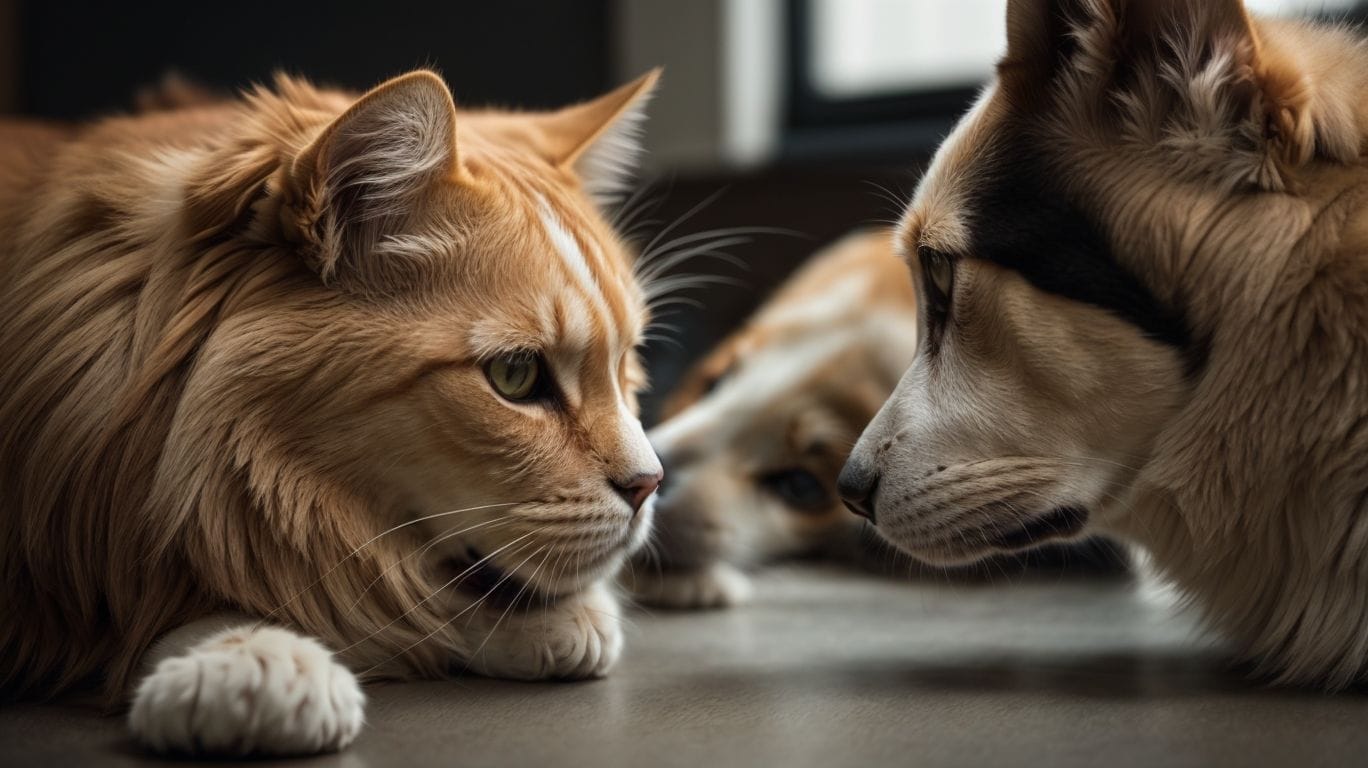
Photo Credits: Petnarnia.Com by Jonathan Scott
Understanding dog and cat behavior is crucial for pet owners in order to establish a harmonious environment at home. Dogs and cats possess distinctive communication styles and body language. Dogs, being pack animals, rely on social hierarchies, while cats, being solitary creatures, value their independence. By comprehending and respecting these differences, conflicts between pets can be prevented. It is vital to provide proper socialization, training, and enrichment for both dogs and cats. Creating positive associations and providing separate spaces for each pet can aid in fostering a peaceful coexistence.
What is the Natural Relationship Between Dogs and Cats?
What is the Natural Relationship Between Dogs and Cats?
The natural relationship between dogs and cats is complex and can vary depending on individual animals. While some dogs and cats may develop a strong bond and become inseparable, others may have a more distant relationship or even display antagonistic interactions. Dogs and cats have different instincts and behaviors that can influence their relationship. Dogs have a hunting instinct, while cats have a natural prey drive, which can sometimes lead to aggressive behavior. With proper socialization, gradual introduction, and positive reinforcement, dogs and cats can learn to coexist peacefully. Understanding their personalities is important in creating a harmonious environment for both pets.
Factors That Influence Dog-Cat Interactions

Photo Credits: Petnarnia.Com by Douglas Robinson
Dog-cat interactions can be influenced by various factors, shaping the dynamics between them. From socialization and prey drive to breed and size, individual personality, and signs of aggression understanding these elements can shed light on how dogs and cats interact. So, let’s dig into these influencing factors and explore how they impact the intricate relationship between our beloved four-legged companions.
Socialization
Socialization plays a vital role in the way dogs and cats interact with each other.
- Early socialization: Introduce dogs and cats to each other at a young age to promote positive associations and reduce fear or aggression towards one another.
- Controlled introductions: Gradually introduce dogs and cats in a controlled environment, such as a neutral space or through a baby gate, to ensure safety and prevent aggressive behavior.
- Positive reinforcement: Reward dogs and cats for calm and friendly behavior during interactions to foster positive associations and discourage aggression.
- Supervision: Always supervise dogs and cats when they are together to prevent any aggressive or antagonistic interactions.
Prey Drive
A dog’s prey drive, which is their instinctive behavior, can have an impact on how they interact with cats and other small animals. It is important to understand and manage this prey drive in order to ensure a harmonious coexistence between dogs and cats. Here are some key factors to consider:
– Socialization: Early socialization with cats can help dogs learn to coexist with them peacefully.
– Breed and Size: Certain breeds may have a stronger prey drive, and smaller dogs may perceive cats as prey.
– Training: Effective training can redirect a dog’s prey drive towards appropriate activities.
– Supervision: It is necessary to closely supervise dogs and cats when they are together to prevent any aggressive behavior.
– Positive Reinforcement: Rewarding calm and non-aggressive behavior can help in managing a dog’s prey drive.
By understanding and addressing a dog’s prey drive, it is possible to create a safe and peaceful environment where dogs and cats can coexist.
Breed and Size
Different breeds and sizes of dogs can have varying interactions with cats. It is important to consider these factors of breed and size when introducing them to ensure a harmonious relationship. Here is a table summarizing the influence of breed and size:
| Breed | Size | Interaction with Cats |
| Shih Tzu | Small | They are less likely to have strong hunting instincts and may coexist peacefully with cats. |
| Labrador Retriever | Medium to Large | They may have a higher prey drive, requiring proper training and supervision when around cats. |
| German Shepherd | Large | May exhibit protective instincts and establish a positive relationship with cats if socialized properly. |
Individual Personality
Individual personality plays a vital role in the dynamics of how dogs and cats interact with each other. Some dogs may possess an inherently easygoing and friendly personality, which makes them more inclined towards harmonious relationships with cats. Conversely, certain dogs may exhibit a dominant or territorial personality, increasing the potential for conflicts with cats. Similarly, cats with a confident and fearless personality are more likely to establish a peaceful coexistence with dogs. It is crucial to consider the unique personality traits of each animal before introducing them to ensure a positive and harmonious relationship. Remember, each animal encompasses their distinct characteristics, and these traits significantly influence their interactions.
Signs of Aggression in Dogs Towards Cats
Signs of Aggression in Dogs towards Cats can manifest in a variety of ways. Growling, barking, lunging, raised fur, and staring are all indicators that a dog may be displaying aggressive behavior toward cats. It’s crucial to recognize these signs in order to prevent any potentially harmful interactions.
- Growling: When a dog emits a low, rumbling growl, it often signifies aggression. If this behavior is not addressed, it can escalate.
- Barking: Excessive or intense barking directed towards cats should be taken seriously as it can be a sign of aggression.
- Lunging: Dogs may lunge towards cats with the intention of causing harm, displaying their aggressive tendencies.
- Raised fur: When dogs feel threatened or ready to attack, they may raise the fur along their back as a defensive display.
- Staring: Intense and prolonged staring from a dog towards cats can indicate their aggressive intentions.
If you observe any of these signs, it is crucial to take appropriate measures to ensure the safety and well-being of both dogs and cats. This can include implementing gradual introductions, seeking professional help, and providing separate spaces for dogs and cats.
Tips for Introducing Dogs and Cats
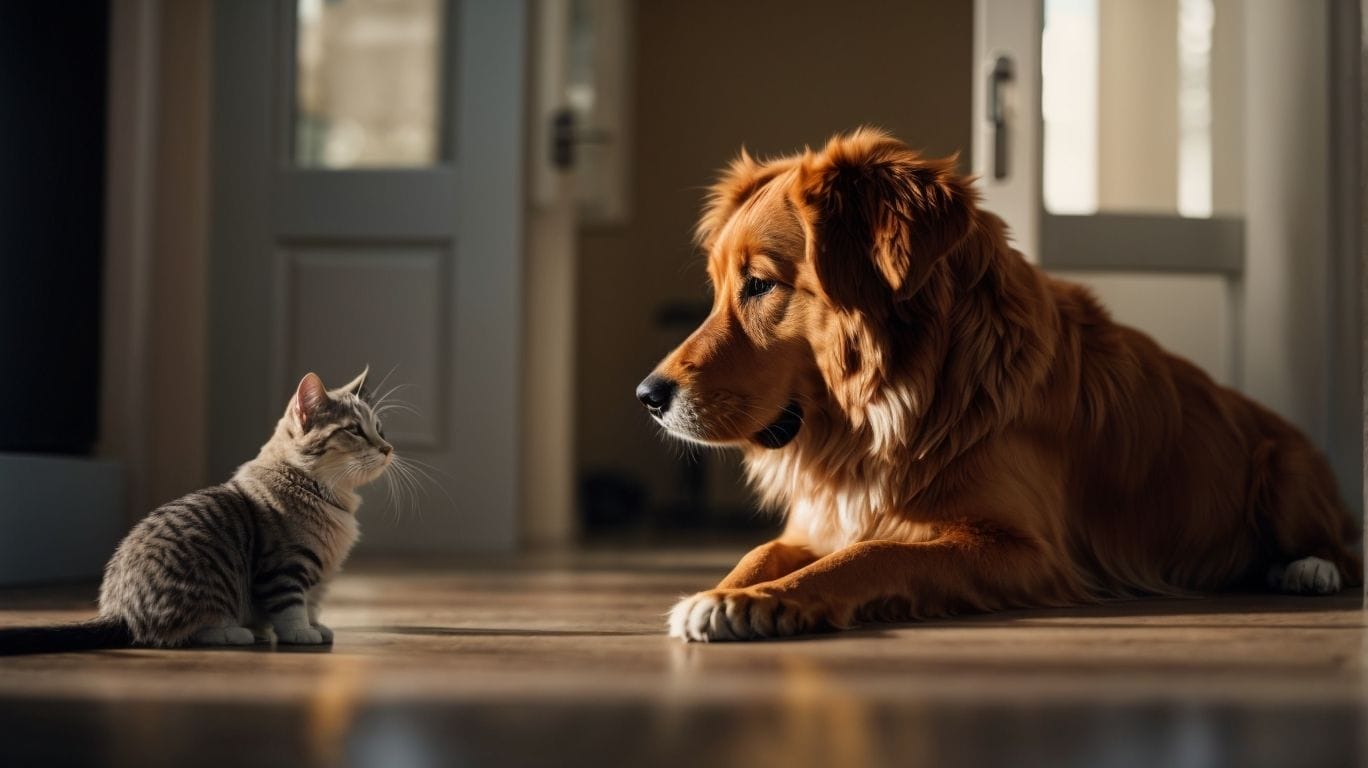
Photo Credits: Petnarnia.Com by Keith Lopez
Discover valuable tips for smoothly introducing dogs and cats in a harmonious setting. Learn about the benefits of a gradual introduction, creating a controlled environment, and implementing positive reinforcement techniques. By following these tried-and-true methods, you can significantly increase the chances of successful and peaceful coexistence between your furry friends. Now, let’s dive into these practical strategies to make the introduction process a breeze!
Gradual Introduction
When introducing dogs and cats, it is crucial to approach the process gradually for a successful gradual introduction. This gradual approach allows them to become familiar with each other’s presence and reduces the risk of aggressive behavior. Start by keeping them in separate rooms and allowing them to sniff each other’s scent under a closed door, which is an essential step in the gradual introduction. After that initial phase, you can slowly introduce them in controlled environments, making use of baby gates or leashes. During this gradual introduction, remember always to provide positive reinforcement and treats when they display calm behavior. It’s important to keep in mind that each animal has its personality, so patience is key. Be sure to monitor their interactions throughout the gradual introduction process closely.
Controlled Environment
Creating a controlled environment is crucial when introducing dogs and cats to ensure their safety and gradual adaptation. Here is a table highlighting key factors in maintaining a controlled environment:
| Factors | Description |
|---|---|
| Supervision | Always supervise interactions between dogs and cats to prevent any aggressive behavior. |
| Separation | Utilize physical barriers like baby gates or separate rooms to control initial interactions. |
| Distraction | Provide distractions such as toys or treats to redirect attention and discourage chasing. |
| Slow and calm pace | Introduce pets gradually and in a calm manner to minimize stress and promote positive encounters. |
| Consistent routines | Stick to regular feeding and exercise schedules to establish predictability and reduce anxiety. |
| Proper introductions | Use scent swapping and controlled visual introductions to familiarize pets with each other’s presence. |
Maintaining a controlled environment fosters a peaceful coexistence between dogs and cats, allowing them to adjust and build positive relationships gradually.
Positive Reinforcement
Positive reinforcement is an effective method for introducing dogs and cats and improving their interactions. Here are some tips for implementing positive reinforcement techniques:
- Use treats and rewards to encourage calm and positive behavior between the animals.
- Praise and pet both animals when they display friendly and non-aggressive behavior towards each other.
- Provide separate spaces and safe zones for both the dog and cat, allowing them to retreat and relax when needed.
- Gradually increase the duration of their interactions, always monitoring their behavior and intervening if any signs of aggression arise.
- Consistency is key – reinforce positive behaviors consistently to create lasting positive associations.
In a heartwarming true story, an abandoned stray dog and a rescued cat were successfully introduced using positive reinforcement techniques. With patience, treats, and praise, the dog’s aggressive behaviors decreased, and the cat’s fear gradually turned into trust. Today, they are best friends and share a loving bond, proving that positive reinforcement can transform even the most challenging animal interactions.
Supervising Dogs and Cats Living Together
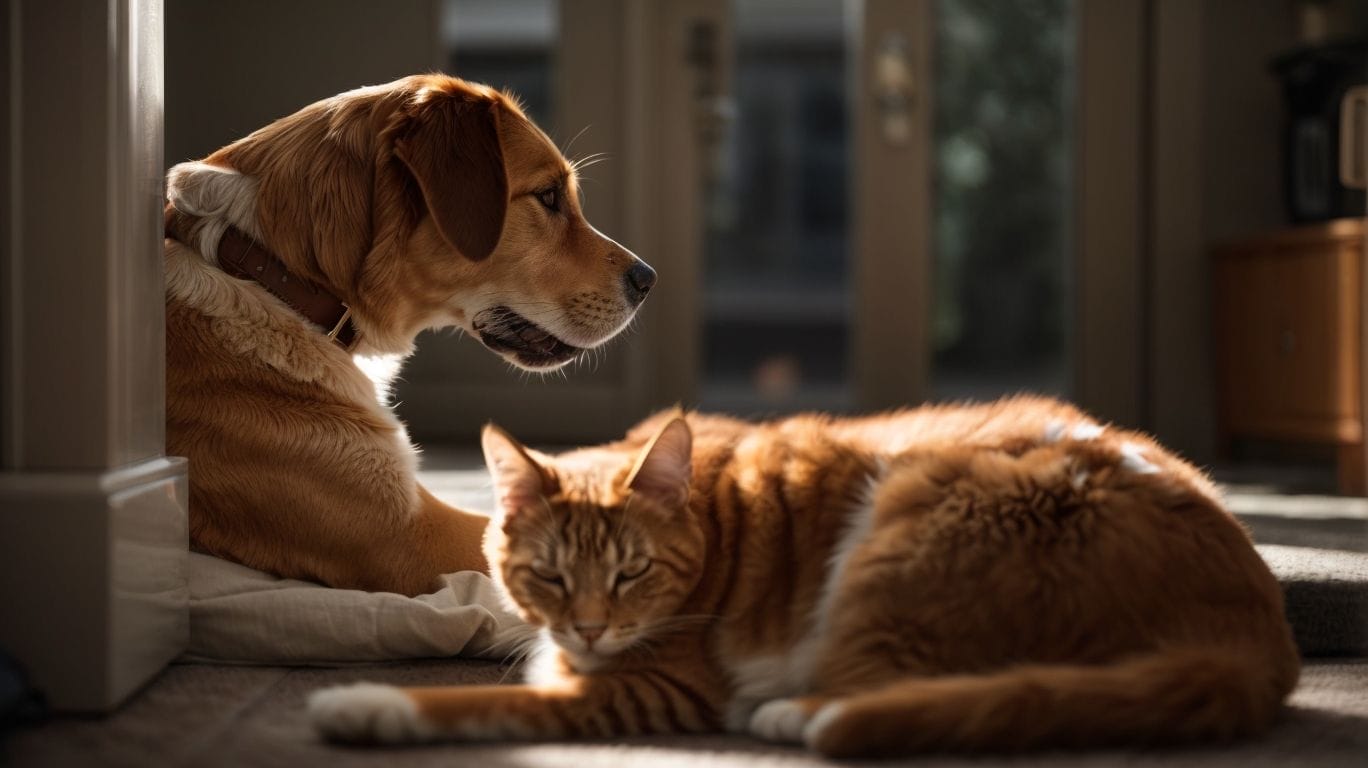
Photo Credits: Petnarnia.Com by Brandon Green
Living with both dogs and cats can be a rewarding experience, but supervising dogs and cats living together is essential for their safety and well-being. Here are some steps to effectively ensure the harmonious coexistence of dogs and cats:
Introduce them slowly and gradually, keeping them separated initially to prevent any confrontations while supervising dogs and cats living together.
Provide separate areas for each pet, including dedicated feeding stations and litter boxes to accommodate both dogs and cats.
Close supervision of their interactions, particularly during the first few weeks, is crucial in establishing positive associations between dogs and cats living together.
Create a safe environment by offering escape routes and high perches specifically designed for cats, as well as implementing baby gates or crates for dogs.
Training both pets in basic obedience commands is vital to setting boundaries and encouraging positive behavior in dogs and cats living together.
What to Do If Your Dog Shows Aggression towards Cats
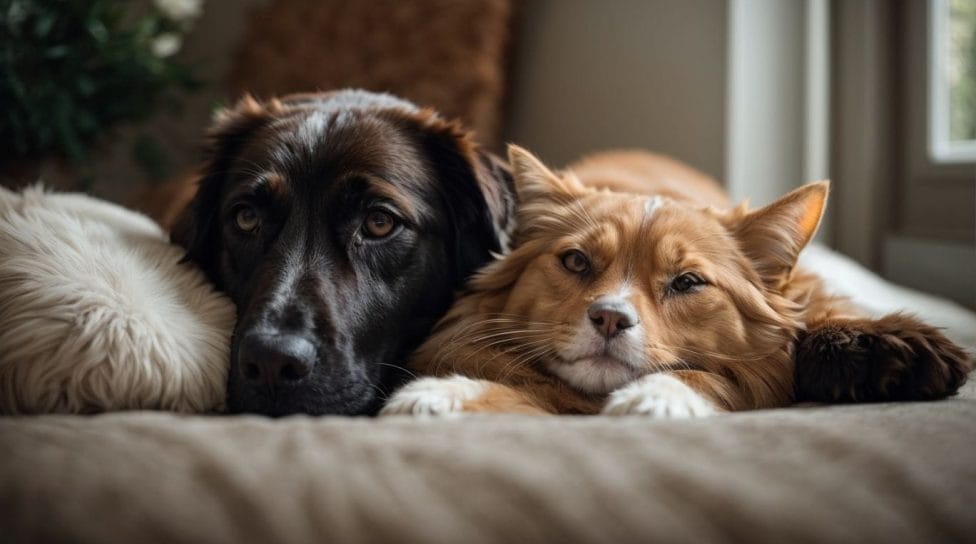
Photo Credits: Petnarnia.Com by Gregory Davis
If your dog shows aggression towards cats, it’s important to take immediate action to ensure the safety of both pets.
What to Do If Your Dog Shows Aggression towards Cats? Here are some steps you can take to address the issue:
- Separate the pets: Keep them in separate areas of your home to prevent any potential harm.
- Gradual introductions: Use a gate or barrier to introduce them while still keeping them physically separated. This allows them to see and smell each other without direct contact.
- Positive reinforcement: Reward your dog for calm behavior around cats using treats or praise.
- Professional help: Consider consulting with a professional dog trainer or behaviorist who specializes in aggression toward cats.
By following these steps, you can work towards creating a safe and harmonious environment for both your dog and cats.
Some Facts About “Will Dogs Eat Cats?”:
- ✅ Dogs rarely eat cats unless they are starving, as most dogs view cats as toys to chase and play with. (Source: Hepper)
- ✅ Stray dogs may kill and eat cats if they have no other food access. (Source: Our Team)
- ✅ Dogs rarely eat other animals they kill unless they are hungry. (Source: Our Team)
- ✅ Dogs can kill cats, usually due to rough play or if the cat is injured and unable to escape. (Source: Our Team)
- ✅ Dogs with strong hunting instincts are more likely to chase and potentially harm cats. (Source: Our Team)
